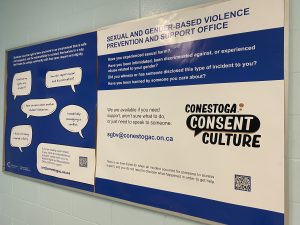3.3 Addressing Issues of Risk
Explain what to do in several high-risk situations
Faculty have a fiduciary responsibility to their students and ensure risk issues are addressed promptly.
Below is some general information, resources, and forms to respond to students in several different high-risk situations. See the relevant websites for dedicated student support services for more information.
For any emergency situation, contact Security Services (x5555).
Student Mental Health Distress and Crisis
5-Minute Video Watch
View a short video overview about the faculty’s role in supporting student mental health and wellness with Sara Kafashan, Teaching and Learning Consultant.
Teaching and Learning. (2023). Faculty’s Role in Supporting Student Mental Health. [Online video]. Panopto.
Students in Distress
A student may be in distress if you notice uncharacteristic changes to their academic performance/behaviour, emotionality, and well-being. There may be one or multiple reasons for a student is distress.
If you notice that a student is in distress or if you are concerned about the student’s well-being, you should respond empathetically and check in with the student directly. Then, refer a student warmly to services to support them.
Mental health resources for students are available in Ontario and worldwide. Consider sharing these links in your course shell.
- 24/7 Crisis support line (1-844-437-3247) if the student lives in the Cambridge, Waterloo, Kitchener, Guelph, Wellington region;
- Good2TALK (call 1-866-925-5454 or text GOOD2TALKON to 686868) if the student lives in Ontario;
- Canadian Crisis Line (call 1-833-456-4566) or Kids Help Phone (call 1-800-668-6868 or text CONNECT to 686868) if the student lives in Canada;
- International SOS Dedicated Line (+1 215-942-8478) if the student is out-of-country.
Faculty should also submit a CARE form to refer the student in distress to the CARE Team. The CARE Team will reach out immediately with appropriate support.
Students in Crisis/Emergency
If you believe that a student is in mental health crisis (e.g., is in immediate safety risk to self or others, such as self-harm, substance overuse, or violence), respond with compassion and contact Campus Security’s emergency services.
- Campus Security Services for emergencies (Extension 5555)
After ensuring the safety of all parties involved, faculty should also follow up by submitting a CARE form for the student to ensure the student receives ongoing support from the College.
Depending on and appropriate to the circumstances, you may wish to contact your Chair/Chair Designate in a live meeting. To protect the student, on a case-by-case basis you may avoid using personal student information.
Harassment and Discrimination
Students are entitled to safe and respectful learning environments, and faculty are responsible for ensuring that the classroom is welcoming. It is essential that faculty actively and deliberately create a non-discriminatory and inclusive learning environment for all students.
Here are some first steps for addressing harassment and discrimination.
- First, and before acting or communicating, review and follow the Discrimination and Harassment Prevention Policy and Procedures for Complaints Against Employees and Complaints Against Students.
- Tell students at the beginning of the term that you facilitate an inclusive and welcoming classroom and that discrimination will not be tolerated.
- Outline Conestoga’s policy so that students have a good understanding of what constitutes discrimination and harassment.
- Do not ask students to speak for an entire group.
- Intervene immediately if discrimination and/or harassment occurs while you are present. Do not let harassment and/or discrimination continue. Address the issue directly with students by taking a break in class.
- Contact Security if there is immediate danger.
- If a student approaches you, believe and support the victim, support all students impacted, and report any complaints as per Conestoga’s procedures.
- NOTE: the role of faculty is not to investigate, but to take all reports/complaints at face value and report according to the policy.
- For instances involving students, alert the Chair (maintaining student confidentiality). For instances involving employees, alert HRpolicy@conestogac.on.ca.
Conestoga respects religious freedom (or creed) and expression and recognizes that this freedom can sometimes be perceived as contrary to the right to sexual orientation, gender identity, and gender expression. It is important to be explicit that rights do not supersede one another.
What should I do if I am harassed?
Address this immediately. If possible, name the behaviour and state that it is wrong. For example, say, “Do not say that. That is discrimination.” Or, “Do not touch me. That is sexual harassment.” Another option is to email the person so you have a record. If the behaviour continues or if you need help, discuss the situation immediately, in confidence. If the respondent (person engaging in unwelcome behaviour) is a student, consult with SRRO. If the respondent is an employee, consult supervisor or contact HRpolicy@conestogac.on.ca .
You can read more at Responding to Discrimination and Harassment in Teaching – Faculty Learning Hub (tlconestoga.ca)
Sexual and Gender-Based Violence

It is difficult to be a faculty member in a position of disclosure, but the College has a detailed policy, procedure, and centralized office for reporting sexual and gender-based violence. This includes students being made uncomfortable because of comments and advances that are sexual in nature.
If faculty become aware of suspected harassment, discrimination, or violence that is sexual or gender-based, faculty should believe the victim, listen empathetically and without judgement, refrain from assessing risk, avoid asking for details, and report the incident.
Faculty should consult with the Sexual and Gender-Based Violence office (email) to be guided on next steps. Note that if a student shares an incident (suspected or known) with you as a faculty member, you have a duty to report to the Sexual and Gender-Based Violence office.
See more information about Sexual assault and sexual violence procedures.
Other Emergency Situations
If a student has a medical emergency or another emergency, like an injury or an anxiety attack, call security immediately by dialing extension 5555 on the in-class telephone. They are the College’s first responders.
Call security as well if you believe that student is in immediate danger (e.g., they have been injured or harmed on campus, or if they threaten to harm themselves or others).
If you are not in a classroom, Emergency Phone Stations are located throughout the hallways on campus: 519-748-5220 Ext. 3357.
Security will collect information from the caller and dispatch help. Prepare to share your name, the nature of the emergency, and a phone or extension where you can be reached. Do NOT hang up the phone until Security has collected all information.
If you are in a virtual classroom (Zoom or Teams), ask the other students to leave the class meeting, then stay on the call until help has been dispatched.
5-Minute Reflection
After reviewing the student support services on this page, consider the following reflection questions:
- Which issues are likely to arise in my classroom?
- Which support services can I recommend to students at the start at the beginning, middle, and end of the semester?
- Which supports should I be aware of for specific high-risk situations?
 Section 3.3 Review
Section 3.3 Review
Please pause and answer these eight practice questions to review and check your learning.
